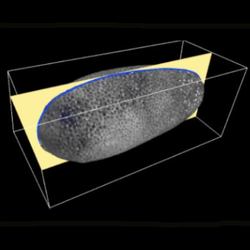Attachment of the blastoderm to the vitelline envelope affects gastrulation of insects.
During gastrulation, physical forces reshape the simple embryonic tissue to form the complex body plans of multicellular organisms1. These forces often cause large-scale asymmetric movements of the embryonic tissue2,3. In many embryos, the gastrulating tissue is surrounded by a rigid protective shell4. Although it is well-recognized that gastrulation movements depend on forces that are generated by tissue-intrinsic contractility5,6, it is not known whether interactions between the tissue and the protective shell provide additional forces that affect gastrulation. Here we show that a particular part of the blastoderm tissue of the red flour beetle (Tribolium castaneum) tightly adheres in a temporally coordinated manner to the vitelline envelope that surrounds the embryo. This attachment generates an additional force that counteracts tissue-intrinsic contractile forces to create asymmetric tissue movements. This localized attachment depends on an αPS2 integrin (inflated), and the knockdown of this integrin leads to a gastrulation phenotype that is consistent with complete loss of attachment. Furthermore, analysis of another integrin (the αPS3 integrin, scab) in the fruit fly (Drosophila melanogaster) suggests that gastrulation in this organism also relies on adhesion between the blastoderm and the vitelline envelope. Our findings reveal a conserved mechanism through which the spatiotemporal pattern of tissue adhesion to the vitelline envelope provides controllable, counteracting forces that shape gastrulation movements in insects.

- Nature. 2019 Apr;568(7752):395-399
- 2019
- Cell Biology
- 30918398
- PubMed
Enabled by:
